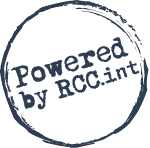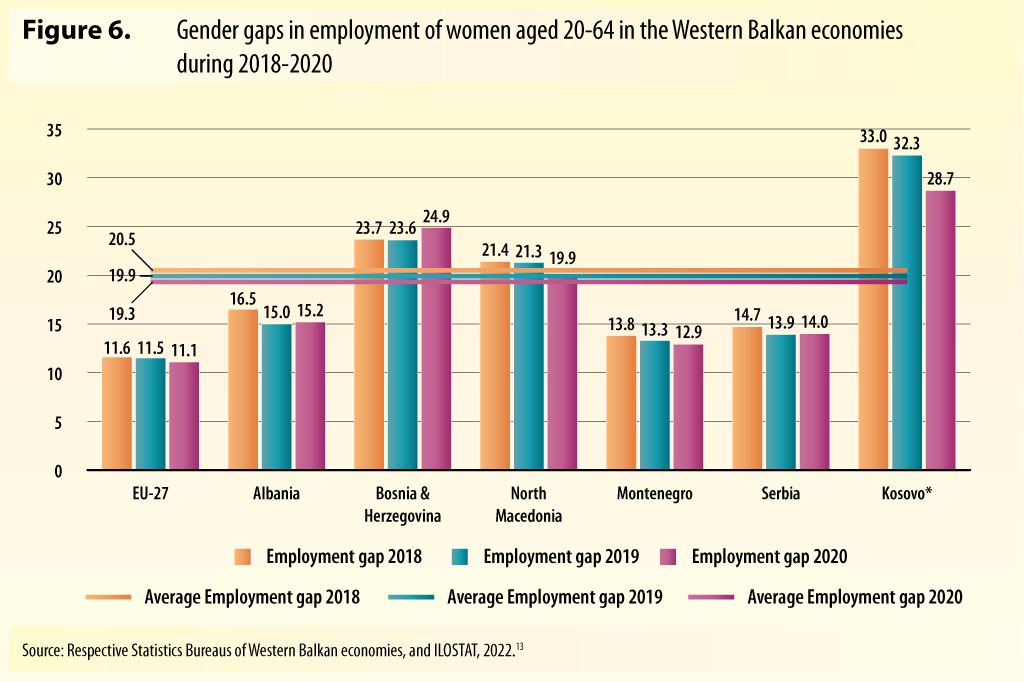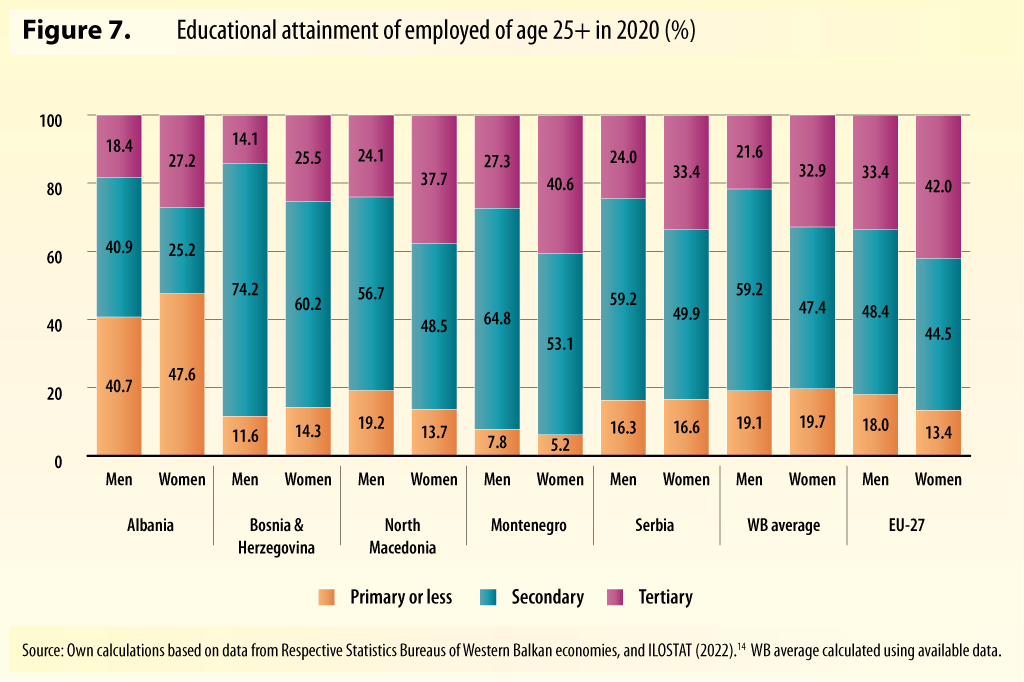
Employment rate of women in the Western Balkans is very low. In 2020, it stood at 44.9%, compared to men at 64.2%, (age bracket 20-64). The gender employment gap in the Western Balkans is 19.3%, while in the European Union (EU) it is 11.1%.
Employed women of more than 25 years old are typically better educated than employed men of the same age in the Western Balkans. On average, in Western Balkans, the percentage of women in employment with higher education is 32.9% compared to 21.6% for men.
The 2020 data for Western Balkan economies show that the category of managerial jobs is the smallest job category across all WB economies. The highest shares of women work in the group of professionals and service and sales workers. The high percentages of professionals may be due to the concentration of women in the teaching and nursing professions, but also since the public sector is an important sector of women employment in WB economies.
The average self-employment share of total employment in the WB economies was 15.8% for women and 21.9% for men, higher than the corresponding EU-27 shares of 9.0% and 14.9%, respectively. In regard to contributing/unpaid family workers, the average WB share is very high compared to EU-27, 9.2% of employed women in the WB economies work as contributing family workers, while in EU-27 only 1.2% of women hold the same work status. The share of contributing men is about half the women’s average, both in the WB and in EU-27.
| Men (%) | Women (%) | |||||
| Economy | 2018 | 2019 | 2020 | 2018 | 2019 | 2020 |
|---|---|---|---|---|---|---|
| EU-27 | 78.2 | 78.9 | 78.0 | 66.6 | 67.4 | 66.9 |
| Albania | 73.9 | 74.7 | 74.0 | 57.4 | 59.7 | 58.8 |
| Bosnia & Herzegovina | 59.5 | 61.6 | 64.9 | 35.8 | 38.0 | 40.0 |
| North Macedonia | 66.6 | 69.7 | 68.9 | 45.2 | 48.4 | 49.0 |
| Montenegro | 66.7 | 67.5 | 61.7 | 52.9 | 54.2 | 48.8 |
| Serbia | 70.5 | 72.1 | 72.9 | 55.8 | 58.2 | 58.9 |
| Kosovo* | 45.3 | 46.2 | 42.8 | 12.3 | 13.9 | 14.1 |
| WB average | 63.8 | 65.3 | 64.2 | 43.2 | 45.4 | 44.9 |
Source:
EUPSR Social Scoreboard, 2021.
| 2018 | 2019 | 2020 | WB average 2018 | WB average 2019 | WB average 2020 | |
|---|---|---|---|---|---|---|
| EU-27 | 11,6 | 11,5 | 11,1 | 20,5 | 19,9 | 19,3 |
| Albania | 16,5 | 15,0 | 15,2 | 20,5 | 19,9 | 19,3 |
| Bosnia & Herzegovina | 23,7 | 23,6 | 24,9 | 20,5 | 19,9 | 19,3 |
| North Macedonia | 21,4 | 21,3 | 19,9 | 20,5 | 19,9 | 19,3 |
| Montenegro | 13,8 | 13,3 | 12,9 | 20,5 | 19,9 | 19,3 |
| Serbia | 14,7 | 13,9 | 14,0 | 20,5 | 19,9 | 19,3 |
| Kosovo* | 33,0 | 32,3 | 28,7 | 20,5 | 19,9 | 19,3 |

Source:
Respective Statistics Bureaus of Western Balkan economies, and ILOSTAT, 2022.
| Primary or less | Secondary | Tertiary | |
|---|---|---|---|
| Men | |||
| Albania | 40,7 | 40,9 | 18,4 |
| Bosnia and Herzegovina | 11,6 | 74,2 | 14,1 |
| North Macedonia | 19,2 | 56,7 | 24,1 |
| Montenegro | 7,8 | 64,8 | 27,3 |
| Serbia | 16,3 | 59,2 | 24,0 |
| WB average | 19,1 | 59,2 | 21,6 |
| EU-27 | 18,0 | 48,4 | 33,4 |
| Women | |||
| Albania | 47,6 | 25,2 | 27,2 |
| Bosnia and Herzegovina | 14,3 | 60,2 | 25,5 |
| North Macedonia | 13,7 | 48,5 | 37,7 |
| Montenegro | 6,2 | 53,1 | 40,6 |
| Serbia | 16,6 | 49,9 | 33,4 |
| WB average | 19,7 | 47,4 | 32,9 |
| EU-27 | 13,4 | 44,5 | 42,0 |

Source:
Own calculations based on data from Respective Statistics Bureaus of Western Balkan economies, and ILOSTAT (2022). WB average calculated using available data.
| Agriculture | Manufacturing | Construction | Mining and quarrying | Trade | Public Administration | |
|---|---|---|---|---|---|---|
| Women | ||||||
| Albania | 41,6 | 14,8 | 0,6 | 0,8 | 21,6 | 20,7 |
| Bosnia and Herzegovina | 20,5 | 14,4 | 0,6 | 1,9 | 32,9 | 29,7 |
| North Macedonia | 13,1 | 23,9 | 1,1 | 1,2 | 31,4 | 29,4 |
| Montenegro | 6,6 | 4,1 | 2,2 | 1,6 | 49,6 | 35,9 |
| Serbia | 13,3 | 16,3 | 0,8 | 1,8 | 33,5 | 34,2 |
| Kosovo* | 2,8 | 5,5 | 1,2 | 0,9 | 40,1 | 49,5 |
| Men | ||||||
| Albania | 32,3 | 7,9 | 12,2 | 3,2 | 31,6 | 12,8 |
| Bosnia and Herzegovina | 16,4 | 21,3 | 12,5 | 7,2 | 27,0 | 15,7 |
| North Macedonia | 14,5 | 17,1 | 11,0 | 6,4 | 33,1 | 18,0 |
| Montenegro | 7,6 | 7,5 | 16,0 | 5,0 | 47,6 | 16,3 |
| Serbia | 17,5 | 20,5 | 7,9 | 5,7 | 30,7 | 17,7 |
| Kosovo* | 4,7 | 14,0 | 16,0 | 3,9 | 40,3 | 21,0 |

Source:
Author’s calculations based on data from ILOSTAT (2022)
| Albania | Bosnia & Herzegovina | North Macedonia | Montenegro | Serbia | Kosovo* | |
|---|---|---|---|---|---|---|
| Managers | 1,1 | 1,8 | 1,4 | 3,8 | 2,1 | 6,3 |
| Professionals | 18,3 | 20,9 | 22,6 | 25,6 | 18,7 | 33,4 |
| Technicians and associate professionals | 3,5 | 11,3 | 13,2 | 15,0 | 12,9 | 7,7 |
| Clerical support workers | 2,1 | 8,8 | 8,0 | 11,7 | 11,1 | 11,1 |
| Service and sales workers | 15,5 | 25,8 | 18,5 | 26,3 | 19,4 | 21,5 |
| Skilled agricultural, forestry and fishery workers | 41,3 | 11,9 | 5,3 | 4,3 | 16,2 | 2,3 |
| Craft and related trades workers | 2,9 | 7,8 | 3,7 | 2,4 | 4,6 | 4,9 |
| Plant and machine operators and assemblers | 8,6 | 1,5 | 14,7 | 0,6 | 5,5 | 0,7 |
| Elementary occupations | 6,6 | 10,1 | 12,6 | 10,1 | 9,5 | 12,1 |
| Armed forces occupations | 0,1 | 0,2 | 0,0 | 0,0 | 0,0 | 0,0 |

Source:
Respective Statistics Bureaus of Albania, Bosnia and Herzegovina, North Macedonia, and Serbia, 2022. Data for Montenegro and Kosovo* are from ILOSTAT, 2022.
| Employee | Self-employed | Unpaid family worker | |
|---|---|---|---|
| Women | |||
| WB average | 75,0 | 15,8 | 9,2 |
| EU-27 | 89,7 | 9,0 | 1,2 |
| North Macedonia | 85,3 | 8,0 | 6,7 |
| Montenegro | 86,8 | 10,1 | 3,1 |
| Serbia | 76,9 | 15,8 | 7,3 |
| Kosovo* | 73,4 | 22,1 | 4,5 |
| Albania | 47,2 | 25,8 | 27,0 |
| Bosnia and Herzegovina | 80,6 | 12,7 | 6,7 |
| Men | |||
| WB average | 73,4 | 21,9 | 4,7 |
| EU-27 | 84,5 | 14,9 | 0,6 |
| North Macedonia | 79,5 | 17,9 | 2,6 |
| Montenegro | 78,7 | 20,0 | 1,2 |
| Serbia | 69,9 | 27,6 | 2,5 |
| Kosovo* | 84,8 | 10,3 | 4,9 |
| Albania | 45,2 | 39,3 | 15,5 |
| Bosnia and Herzegovina | 82,2 | 16,4 | 1,4 |

Source:
Respective Statistics Bureaus of Western Balkan economies, 2022.
